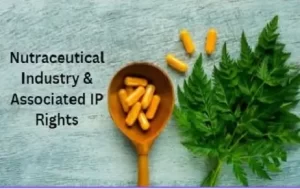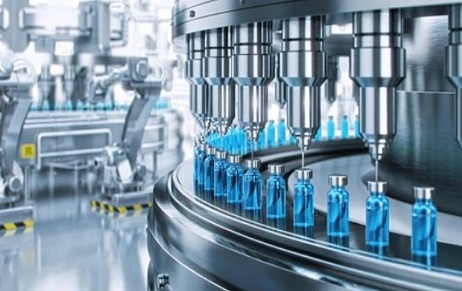A social media influencer is someone who creates content based on their niche in various…
Nutraceutical Industry & Associated IP Rights
Introduction
In the current world scenario, people started to give attention to health and related parameters. Subsequently, the healthcare sector has gained precedence and command over the market. The global nutraceutical market (including functional food, functional beverages, and dietary supplements) is anticipated to grow by 7.5% (CAGR) between 2022 and 2027, in which the United State market share is considered to be the biggest. Due to the big hit of the nutraceutical sector, companies are looking forward to developing innovations and striving to keep up with consumer trends.

Nutraceuticals are composed of 2 words nutrients and pharmaceuticals. It implies that nutraceuticals are a substance that offers essential nutrients for a well-functioning body and some therapeutic utilities. It includes products that are withdrawn from the natural food source and are being enhanced to provide additional health benefits.
(A) Type of nutraceuticals product
- Dietary Supplement: these products are made by driving out nutrients from natural food and then concentrating them in liquid, capsule, or powder form, such as arginine, casein, etc.
- Functional Foods: These foods have been supplemented and fortified with nutrients not present in their natural state. As a result, they provide significant health benefits by lowering the risk of several serious diseases.
- Medicinal Foods: These foods are used in dietary management for certain conditions and are very specific to their purpose. They are administered and supervised by medical experts.
- Farmaceuticals: Food products that are derived from crops or animals. These foods have medically valuable components and are highly cost-effective.
(B) Benefits of Nutraceuticals
- Nutraceutical product plays a positive role in several biological processes: such as antioxidative stress defense, cell proliferation management, gene expression enhancement, and mitochondrial integrity protection.
- Nutraceutical products are expected to increase life expectancy: They may prolong life by assisting the body’s functioning and safeguarding its integrity. They have also been proposed to improve the quality of life by preventing chronic diseases, reducing aging, and enhancing overall health.
- Nutraceutical products are expected to boost immunity and influence certain diseases: They have tendencies to modify conditions, which involve influencing the pathophysiology of the disease to lessen its activity and development and hence result in a better outcome.
Growth of the Nutraceutical Industry
The healthy food movement has been on the rise in recent years, and its importance has grown since the time of pandemic began. People start to acknowledge the necessity of living a better lifestyle, which gives a boost to the Nutraceuticals Industry. Moreover, for most consumers, it also works as a cost-effective substitute against expensive treatments across various markets. Thus, consumer demand will remain the primary driver for the solid growth of the market.
The prominent market share for Nutraceutical products is held by the United States, Europe, and India. However, by the year 2030, it is expected that China will surpass them all.
At present, the United States has the world’s largest Nutraceutical market. Due to consumer demand, many US companies are considering including nutraceutical products in their product line. This inclusion is the consequence of a push from health-conscious consumers.
Whereas, The European Nutraceutical industry is expected to increase at a 7.5% CAGR between 2020 and 2025. While the Netherlands, Germany, and Sweden may emerge as Nutraceuticals market innovation hubs, Spain and the United Kingdom may prove to be critical test markets for new products.
And in India, the nutraceuticals industry is expected to expand from USD 4 billion in 2017 to USD 18 billion by 2025. There are several reasons for this. The first and most noticeable is the increased need for dietary supplements. Second, approximately 15% of the Indian population is malnourished, a significant percentage given the country’s massive population. And the government has taken many steps to reduce it, including Integrated Child Development Services (ICDS), the National Health Mission (NHM), and the mid-day meal program. Nutraceuticals play an essential part in these services by meeting nutritional needs at reasonable prices.
Challenges in Regulations of the Nutraceutical Sector
The regulations in the nutraceutical industry present a significant obstacle. The main source of concern is the variance in definition across the market. This disparity impedes the product’s goal of globalization. In Japan, for example, functional foods are defined by their components and must only contain natural ingredients. In the United States, on the other hand, functional foods provide certain health benefits in addition to the obvious essential nourishment. They may also include biotechnological items. Furthermore, there are no explicit regulations governing Nutraceuticals.
In the US, the Nutraceutical sector is regulated by Dietary Supplement Health and Education Act (DSHEA). This regulation provides the responsibility of the manufacturer, and as per this regulation, product registration is not necessary. However, companies are required to provide proper and genuine information on the label of the product.
In Europe, the Nutraceutical sector is regulated by the European Food and Safety Authority (EFSA), and the regulations of the nutraceutical sector come under Directive 2002/46/EC. And as per Europe regulations on the nutraceutical sector, before getting into the market the products are required to fulfill certain requirements to ensure the safety of the product.
Whereas in India, there is no specific regulation has been assigned to the Nutraceutical sector. However, the manufacturing, storage, distribution, sale, and import of nutraceutical products come into the purview of the Food Safety and Standards Act of 2006 (FSSA).
Intellectual Property Rights in Nutraceuticals
Protecting intellectual property (IP) originating from the sector’s research and development can assist enterprises in maintaining their competitive advantage by preventing others from exploiting the rewards of their labor. As with other innovative industries, various types of protectable IP rights apply to the nutraceutical sector with variable values, such as
Patent Protection
For companies to protect their innovation from being by a copy by other competitors it is necessary to file for a patent grant. There are two types of patents, which are:
- Utility Patent: this type of patent protects the novel, non-obvious composition, formulation, manufacturing process, and method of usage.
- Device Patent: it protects the ornamental design of something that has a practical utility.
Trademark Protection
Trademark registration provides companies with a unique market identity which helps the consumer to identify and distinguish the brand. By trademark registration companies can protect their packaging and labeling of the product along with the slogan and logo of the company.
III. Trade Secrets
It protects a business secret which helps them differentiate itself from other competitors. To be recognized as a trade secret, the information should have the following:
- There should be some commercial value.
- It should not be public information.
- It should be reasonably protected by the rightful secret holder.
Unlike patents and trademarks, trade secrets do not need to be registered, do not expire, and are not disclosed to the public.
A Nutraceutical corporation may wish to safeguard several types of knowledge through trade secrets. This includes safeguarding the production method, which may otherwise be found through reverse engineering if the process was patent-protected. Similarly, the list of ingredient suppliers can be preserved as a trade secret. Furthermore, a specific physiological process that improves a physiological function can be considered a trade secret. Finally, if other FDA conditions are met, even the amount of individual ingredients within a proprietary blend can be preserved as a trade secret.
The sole disadvantage of a trade secret is that if a secret recipe can be reverse-engineered, it will no longer be a secret, hence securing a patent may be the better option in these situations.
Conclusion
Nutraceuticals offer its consumers innovative products that serve their immediate health-conscious needs. the Nutraceuticals industry has a growing market however the regulation of the sector can be complicated due to global differences. However, It is still a very new market because of which new companies are entering the market which makes it necessary to protect innovation through Intellectual Property Right (IPR) which also help companies to gain market traction.
Author : Mudit Gupta, in case of any queries please contact/write back to us via email to [email protected] or at IIPRD.
References
- https://www.crnusa.org/regulation-legislation/fda-ftc-regulations/dietary-supplement-health-education-act-dshea
- https://www.news-medical.net/health/Nutraceutical-Regulation.aspx
- https://foodsafetyhelpline.com/fssai-registration-licensing-and-compliance-for-nutraceuticalshealth-suppliments/?nowprocket=1
- https://www.vitafoodsinsights.com/regulation/ip-rights-nutraceutical-sector
- https://michelsonip.com/what-is-a-design-patent/?nowprocket=1
- https://www.wipo.int/tradesecrets/en/



